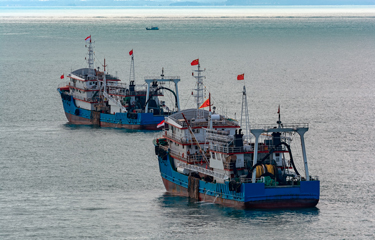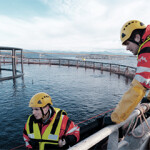Report finds China becoming more secretive about its fishing subsidies

A new study prepared for campaign group Oceana suggests 85 percent of China’s subsidies to its fleet are harming the sustainability of fish stocks.
The report, “China’s Fisheries Subsidies Propel Distant-Water Fleet,” found that while China has reduced its fuel subsidies to the distant-water fleet, it is becoming more secretive about releasing data on direct and indirect subsidies to fishing firms.
Compiled by a group of researchers led by China Ocean Institute CEO Tabitha Mallory, who is also an affiliate professor at the University of Washington and an expert on China’s fishing fleet, the report suggests China’s central government stopped tracking fuel subsidies to its distant-water fishing industry in 2016. Mallory said the move came as part of a larger trend toward less transparency in the country’s financing of the seafood sector.
A key source for the Oceana report was the China Fisheries Yearbook, which in 2015 stopped publishing details on fisheries subsidies programs. Further obfuscating matters, in 2012, China stopped reporting its fuel subsidies to its distant-water fleet for operations beyond China’s territorial waters, which are themselves disputed, since China’s claims in the South China Sea are contested. To account for missing data, the report’s researchers made “conservative estimates based on trends in the data that were available in other government publications, media reports, and academic literature.”
“China’s distant-water fishing fleet brings in just 22 percent of the country’s total catch, but receives 42 percent of total subsidies, adding further evidence that subsidies are propping up an otherwise unprofitable fleet,” the Oceana report said. “China provides its distant-water industry an estimated CNY 11.88 billion [USD 1.75 billion, EUR 1.53 billion] in harmful subsidies, over half of which supports vessels operating on the high seas.”
Mallory calculated China reduced its subsidies of its capture fisheries sector from CNY 27.23 billion (USD 4.08 billion, EUR 3.53 billion) in 2014 to CNY 20.26 billion (USD 3.03 billion, EUR 2.62 billion) in 2019. The bulk of those came a result of a government policy that cut national fleet subsidies by 40 percent between 2014 and 2019 as part of an effort to address chronic domestic overfishing. China’s domestic-water subsidies were reduced from CNY 24.20 billion (USD 3.63 billion, EUR 3.14 billion) in 2014 to CNY 9.20 billion (USD 1.38 billion, EUR 1.19 million) in 2019. Distant-water fuel subsidies also dropped from CNY 2.68 billion (USD 402 million, EUR 348 million) in 2011 – when they were last officially reported – to approximately CNY 953 million (USD 142 million, EUR 123.8 million) in 2019, according to the report.
Oceana estimated China’s distant-water fisheries received 42 percent of the value of China’s marine-capture fisheries subsidies, worth CNY 28.19 billion (USD 4.16 billion, EUR 3.79 billion). Of that total, Oceana estimated 15 percent provided a sustainable benefit, in the form of paying fishermen to retire vessels and to release fingerlings into depleted waters. China’s indirect subsidies to its ocean-going fleet come in the form of tax breaks and preferential loans account for 58 percent of total subsidies to the distant-water industry.
While China’s official tally of its fuel subsidies has decreased, subsidies for the construction of distant-water fishery bases – which China began offering in 2016 – now make up 57 percent of direct subsidies supporting its distant-water fishery. Distant-water fishery bases are ports, processing and warehousing facilities established by Chinese fishing companies in other countries. Under the auspices of China’s Belt and Road Initiative, Chinese fishery bases have been built in Mauritania and Guyana by the Fujian-based firm Fuzhou Hong Dong Pelagic Fishery. In Guyana, the firm recently built a USD 25 million (EUR 21.1 million) plant to process white-belly shrimp (Nematopalaemon schmitti) and other species for export to China, and Hong Dong Chairman and CEO Lan Ping Yong said the company is looking to build another base in Suriname. Last December, another Chinese firm, China Ocean Group Development Limited, announced it had signed a memorandum of understanding with the Mercosur trade bloc to build a fishing base in Ecuador, but its claims were rejected by Mercosur and Ecuadorian authorities.
China’s decreasing transparency comes as World Trade Organization negotiators are seeking an agreement on ending harmful fishing subsidies. A key part of the ongoing negotiations has been an attempt to determine standards for robust reporting of data on subsidies. Thus far, China’s negotiators have been coy about the conditions under which they would agree to any WTO deal, and particularly if it includes data-reporting provisions. Article 8 in the WTO’s most-recent draft text, which covers transparency requirements, was the subject of an Indian proposal that would require members to submit information on fuel subsidies, including blanket fuel-subsidy programs not intended for fisheries in particular. The proposal has been well-received by many delegations as an alternative to an outright prohibition – including European members, some of whom opposed the prohibition of non-specific fuel subsidies.
A lack of a level playing-field between the European and Chinese fishing industries, caused in part by significant subsidization of the Chinese fleet, has been a long-running problem, according to Daniel Voces, the managing director of the European Union’s primary fishing industry advocacy group, Europêche,
“Subsidized Chinese seafood products compete unfairly in the E.U. market with seafood produced sustainably by the E.U. fishing fleet,” Voces said in response to the Oceana report. “Europe and the international community should make a stand immediately at WTO and require China to respect the principles of transparency, sustainability, accountability, and good governance.”
Voces told SeafoodSource a lack of clear and accurate reporting from China makes tackling the problem of harmful fishing subisidies much harder to accomplish.
“The alleged decrease in [China’s] fuel subsidies runs in parallel with the growing opacity under which the Chinese administration builds and manages these incentives. Indeed, back in April 2016, the United States issued a formal request to the WTO asking China to clarify and bring in line with WTO stipulations more than 30 support programs for China's fisheries sector. To date, the issue is far from being resolved. We can only make an educated guess on the level of subsidies granted by the Chinese authorities, which are always based on estimates,” Voces said. “We can never be sure whether a reduction is indeed real or not.”
Photo courtesy of Igor Grochev/Shutterstock






Share